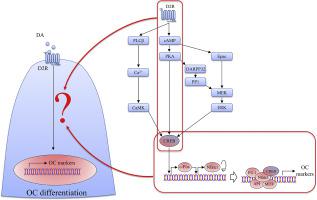Cellular Signalling ( IF 4.4 ) Pub Date : 2020-11-24 , DOI: 10.1016/j.cellsig.2020.109847 Lufei Wang 1 , Lichi Han 2 , Peng Xue 1 , Xiangxiang Hu 1 , Sing-Wai Wong 3 , Meng Deng 4 , Henry C Tseng 5 , Bo-Wen Huang 6 , Ching-Chang Ko 6

|
How the nervous system regulates bone remodeling is an exciting area of emerging research in bone biology. Accumulating evidence suggest that neurotransmitter-mediated inputs from neurons may act directly on osteoclasts. Dopamine is a neurotransmitter that can be released by hypothalamic neurons to regulate bone metabolism through the hypothalamic-pituitary-gonadal axis. Dopamine is also present in sympathetic nerves that penetrate skeletal structures throughout the body. It has been shown that dopamine suppresses osteoclast differentiation via a D2-like receptors (D2R)-dependent manner, but the intracellular secondary signaling pathway has not been elucidated. In this study, we found that cAMP-response element binding protein (CREB) activity responds to dopamine treatment during osteoclastogenesis. Considering the critical role of CREB in osteoclastogenesis, we hypothesize that CREB may be a critical target in dopamine's regulation of osteoclast differentiation. We confirmed that D2R is also present in RAW cells and activated by dopamine. Binding of dopamine to D2R inhibits the cyclic adenosine monophosphate (cAMP)/protein kinase A (PKA) signaling pathway which ultimately decreases CREB phosphorylation during osteoclastogenesis. This was also associated with diminished expression of osteoclast markers that are downstream of CREB. Pharmacological activation of adenylate cyclase (to increase cAMP production) and PKA reverses the effect of dopamine on CREB activity and osteoclastogenesis. Therefore, we have identified D2R/cAMP/PKA/CREB as a candidate pathway that mediates dopamine's inhibition of osteoclast differentiation. These findings will contribute to our understanding of how the nervous and skeletal systems interact to regulate bone remodeling. This will enable future work toward elucidating the role of the nervous system in bone development, repair, aging, and degenerative disease.
中文翻译:

多巴胺通过 cAMP/PKA/CREB 通路抑制破骨细胞分化
神经系统如何调节骨重塑是骨生物学新兴研究的一个令人兴奋的领域。越来越多的证据表明,神经递质介导的神经元输入可能直接作用于破骨细胞。多巴胺是一种神经递质,可由下丘脑神经元释放,通过下丘脑-垂体-性腺轴调节骨代谢。多巴胺也存在于穿透全身骨骼结构的交感神经中。已显示多巴胺通过 D2 样受体 (D2R) 依赖性方式抑制破骨细胞分化,但细胞内二级信号通路尚未阐明。在这项研究中,我们发现 cAMP 反应元件结合蛋白 (CREB) 活性在破骨细胞生成过程中对多巴胺治疗有反应。考虑到 CREB 在破骨细胞生成中的关键作用,我们假设 CREB 可能是多巴胺调节破骨细胞分化的关键靶点。我们证实 D2R 也存在于 RAW 细胞中并被多巴胺激活。多巴胺与 D2R 的结合抑制了环磷酸腺苷 (cAMP)/蛋白激酶 A (PKA) 信号通路,最终降低了破骨细胞生成过程中的 CREB 磷酸化。这也与 CREB 下游破骨细胞标志物的表达减少有关。腺苷酸环化酶(以增加 cAMP 产生)和 PKA 的药理学激活可逆转多巴胺对 CREB 活性和破骨细胞生成的影响。因此,我们已将 D2R/cAMP/PKA/CREB 确定为介导多巴胺抑制破骨细胞分化的候选途径。这些发现将有助于我们了解神经和骨骼系统如何相互作用以调节骨骼重塑。这将使未来的工作能够阐明神经系统在骨骼发育、修复、衰老和退行性疾病中的作用。











































 京公网安备 11010802027423号
京公网安备 11010802027423号